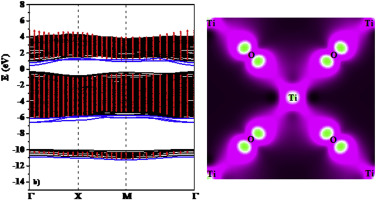当前位置:
X-MOL 学术
›
Solid State Sci.
›
论文详情
Our official English website, www.x-mol.net, welcomes your feedback! (Note: you will need to create a separate account there.)
Surface electronic structure, thermodynamic stability of Na1/2Bi1/2TiO3 (001) surfaces and their relevance to A-site cation ordering in bulk phases: A first-principles study
Solid State Sciences ( IF 3.5 ) Pub Date : 2020-04-01 , DOI: 10.1016/j.solidstatesciences.2020.106161 P. Karuna Kumari , Manish K. Niranjan
Solid State Sciences ( IF 3.5 ) Pub Date : 2020-04-01 , DOI: 10.1016/j.solidstatesciences.2020.106161 P. Karuna Kumari , Manish K. Niranjan

|
Abstract Surface electronic structure and energetics of (001) surfaces of relaxor ferroelectric Na1/2Bi1/2TiO3 (NBT) are explored theoretically within the framework of ab-initio density functional theory. In particular, polar and nonpolar surfaces of tetragonal NBT with bulk P4mm and P4bm symmetries are explored. For P4mm symmetry, (NaO)-, (BiO)+ and (TiO2)0 terminated surfaces and for P4bm symmetry, (Na1/2Bi1/2O)0 and (TiO2)0 -terminated surfaces are considered. The surface electronic structures for different terminations are found to differ with respect to bulk and with each other due to different polarity compensation mechanisms. In case of (BiO)+ and (NaO)- terminated surfaces, the Fermi level shifts slightly above the conduction band minimum (CBM) and below the valence band minimum (VBM) respectively. The resulting localized surface gap states near the VBM and CBM provides sufficient positive and negative charge required for compensation in agreement with the polarity compensation criteria. Furthermore, localized surface states are also formed at energies (~12 eV) deep in the gap below the VBM. The relative thermodynamic stability, reconstructions and relaxations of NBT surfaces may be expected to be correlated with the formation of these deep energy localized surface states. The magnitudes of surface relaxations are found to depend strongly on the nominal charges of the surfaces. The surface energies of polar NaO, BiO and nonpolar TiO2 terminations are found to be significantly larger than that of nonpolar Na1/2Bi1/2O termination. Thus the arrangement of nonpolar-nonpolar planes forming the sequence –Na1/2Bi1/2O–TiO2–Na1/2Bi1/2O–TiO2- may be expected to be more favourable than the sequence of polar-nonpolar planes -NaO-TiO2-BiO-TiO2-NaO-. This favourable arrangement of nonpolar planes may likely influence the degree of A-site cation ordering in Na1/2Bi1/2TiO3 which in turn may influence the degree of coexistence of R3C and CC phases of NBT at the room temperature.
中文翻译:

Na1/2Bi1/2TiO3 (001) 表面的表面电子结构、热力学稳定性及其与体相中 A 位阳离子排序的相关性:第一性原理研究
摘要 在 ab-initio 密度泛函理论的框架内,从理论上探索了弛豫铁电体 Na1/2Bi1/2TiO3 (NBT) 的 (001) 表面的表面电子结构和能量学。特别是,探索了具有体 P4mm 和 P4bm 对称性的四方 NBT 的极性和非极性表面。对于 P4mm 对称性,考虑了 (NaO)-、(BiO)+ 和 (TiO2)0 封端表面,而对于 P4bm 对称性,考虑了 (Na1/2Bi1/2O)0 和 (TiO2)0 封端表面。由于不同的极性补偿机制,不同终端的表面电子结构在体量和彼此之间存在差异。在 (BiO)+ 和 (NaO)- 终止表面的情况下,费米能级分别略微高于导带最小值 (CBM) 和低于价带最小值 (VBM)。所得的 VBM 和 CBM 附近的局部表面间隙状态提供了与极性补偿标准一致的补偿所需的足够的正负电荷。此外,局部表面态也在 VBM 下方的间隙深处以能量 (~12 eV) 形成。NBT 表面的相对热力学稳定性、重建和弛豫可能与这些深层能量局部表面态的形成有关。发现表面弛豫的大小很大程度上取决于表面的标称电荷。发现极性 NaO、BiO 和非极性 TiO2 终端的表面能显着大于非极性 Na1/2Bi1/2O 终端的表面能。因此,形成序列-Na1/2Bi1/2O-TiO2-Na1/2Bi1/2O-TiO2-的非极性-非极性平面的排列可能比极性-非极性平面-NaO-TiO2-BiO-的序列更有利TiO2-NaO-。这种非极性平面的有利排列可能会影响 Na1/2Bi1/2TiO3 中 A 位阳离子的有序度,进而可能影响室温下 NBT 的 R3C 和 CC 相的共存程度。
更新日期:2020-04-01
中文翻译:

Na1/2Bi1/2TiO3 (001) 表面的表面电子结构、热力学稳定性及其与体相中 A 位阳离子排序的相关性:第一性原理研究
摘要 在 ab-initio 密度泛函理论的框架内,从理论上探索了弛豫铁电体 Na1/2Bi1/2TiO3 (NBT) 的 (001) 表面的表面电子结构和能量学。特别是,探索了具有体 P4mm 和 P4bm 对称性的四方 NBT 的极性和非极性表面。对于 P4mm 对称性,考虑了 (NaO)-、(BiO)+ 和 (TiO2)0 封端表面,而对于 P4bm 对称性,考虑了 (Na1/2Bi1/2O)0 和 (TiO2)0 封端表面。由于不同的极性补偿机制,不同终端的表面电子结构在体量和彼此之间存在差异。在 (BiO)+ 和 (NaO)- 终止表面的情况下,费米能级分别略微高于导带最小值 (CBM) 和低于价带最小值 (VBM)。所得的 VBM 和 CBM 附近的局部表面间隙状态提供了与极性补偿标准一致的补偿所需的足够的正负电荷。此外,局部表面态也在 VBM 下方的间隙深处以能量 (~12 eV) 形成。NBT 表面的相对热力学稳定性、重建和弛豫可能与这些深层能量局部表面态的形成有关。发现表面弛豫的大小很大程度上取决于表面的标称电荷。发现极性 NaO、BiO 和非极性 TiO2 终端的表面能显着大于非极性 Na1/2Bi1/2O 终端的表面能。因此,形成序列-Na1/2Bi1/2O-TiO2-Na1/2Bi1/2O-TiO2-的非极性-非极性平面的排列可能比极性-非极性平面-NaO-TiO2-BiO-的序列更有利TiO2-NaO-。这种非极性平面的有利排列可能会影响 Na1/2Bi1/2TiO3 中 A 位阳离子的有序度,进而可能影响室温下 NBT 的 R3C 和 CC 相的共存程度。


























 京公网安备 11010802027423号
京公网安备 11010802027423号